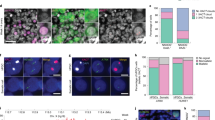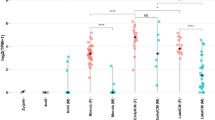Abstract
ONLY about 1% of human XO conceptuses survive to birth and these usually have the characteristics of Turner's syndrome, with a complex and variable phenotype including short stature, gonadal dysgenesis and anatomical defects1. Both the embryonic lethality and Turner's syndrome are thought to be due to monosomy for a gene or genes common to the X and Y chromosomes2. These genes would be expected to be expressed in females from both active and inactive X chromosomes to ensure correct dosage of gene product. Two genes with these properties are ZFX and RPS4X, both of which have been proposed to play a role in Turner's syndrome3,4. In contrast to humans, mice that are XO are viable with no prenatal lethality (P. Burgoyne, personal communication) and are anatomically normal and fertile. We have devised a system to analyse whether specific genes on the mouse X chromosome are inactivated, and demonstrate that both Zfx and Rps4X undergo normal X-inactivation in mice. Thus the relative viability of XO mice compared to XO humans may be explained by differences between the two species in the way that dosage compensation of specific genes is achieved.
This is a preview of subscription content, access via your institution
Access options
Subscribe to this journal
Receive 51 print issues and online access
$199.00 per year
only $3.90 per issue
Buy this article
- Purchase on Springer Link
- Instant access to full article PDF
Prices may be subject to local taxes which are calculated during checkout
Similar content being viewed by others
References
Turner, H. H. Endocrinology 23, 566–574 (1938).
Ferguson-Smith, M. A. J. med. Genet. 2, 142–155 (1965).
Burgoyne, P. Nature 342, 860–862 (1989).
Fisher E. M. C. et al. Cell 63, 1205–1218 (1990).
Lyon, M. F., Searle, A. G., Ford, C. E. & Ohno, S. A. Cytogenetics 3, 306–323 (1964).
Bonhomme, F. & Guenet, J.-L. in Genetic Variants and Strains of the Laboratory Mouse 2nd edn (eds Lyon, M. & Searle, A. G.) 649–662. (Oxford University Press, 1989).
McMahon, A. & Monk, M. Genet. Res. 41, 69–83 (1982).
Rastan, S. J. Embryol. exp. Morph. 78, 1–22 (1983).
Cattanach, B. M. & Johnston, P. Hereditas 94, 5 (1981).
Johnston, P. G. & Cattanach, B. M. Genet. Res. 37, 151–160 (1981).
Rastan, S. Genet. Res. 40, 139–147 (1982).
Schneider-Gadicke, A., Beer-Romero, P., Brown, L. G., Nussbaum, R. & Page, D. C. Cell 57, 1247–1258 (1989).
Brown, C. J. & Willard, H. F. Am. J. hum. Genet. 45, 592–598 (1989).
Page, D. C. et al. Cell 51, 1091–1104 (1987).
Palmer, M. S. et al. Nature 342, 830–836 (1989).
Koopman, P., Ashworth, A. & Lovell-Badge, R. Trends Genet. 7, 132–136 (1991).
Koopman, P. et al. Nature 342, 940–942 (1989).
Ashworth, A., Skene, B., Swift, S. & Lovell-Badge, R. H. EMB0 J. 9, 1529–1534 (1990).
Mardon, G. et al. Molec. cell. Biol. 10, 681–688 (1990).
DeMars, R., LeVan, S. L., Trend, B. L. & Russell, L. B. Proc. natn. Acad. Sci. U.S.A. 73, 1693–1695 (1976).
Tettenborn, U., Dofuku, R. & Ohno, S. Nature 234, 37–40 (1971).
Chomczynski, P. & Scacchi, N. Analyt. Biochem. 162, 156–159 (1987).
Veres, G., Gibbs, R. A., Scherer, S. E. & Caskey, C. T. Science 237, 415–417 (1987).
Chang, C., Kokontis, J. & Liao, S. Proc. natn. Acad. Sci. U.S.A. 85, 7211–7215 (1988).
Mitchell, M. et al. Genetics 121, 803–809 (1989).
Devi, K. R. G., Chan, Y.-L. & Wool, I. G. Biochim. biophys. Acta 1008, 258–262 (1989).
Lovell-Badge, R. H. & Robertson, E. Development 109, 635–646 (1990).
Gubbay, J. et al. Development 109, 647–653 (1990).
Gubbay, J. et al. Nature 346, 245–250 (1990).
Author information
Authors and Affiliations
Rights and permissions
About this article
Cite this article
Ashworth, A., Rastan, S., Lovell-Badge, R. et al. X-chromosome inactivation may explain the difference in viability of XO humans and mice. Nature 351, 406–408 (1991). https://doi.org/10.1038/351406a0
Received:
Accepted:
Issue Date:
DOI: https://doi.org/10.1038/351406a0
This article is cited by
-
Cytogenetic evaluation of primary amenorrhea: a study of 100 cases at tertiary centre
Egyptian Journal of Medical Human Genetics (2022)
-
Epigenetics in Turner syndrome
Clinical Epigenetics (2018)
-
Human germ cell formation in xenotransplants of induced pluripotent stem cells carrying X chromosome aneuploidies
Scientific Reports (2014)
-
A cross-species comparison of escape from X inactivation in Eutheria: implications for evolution of X chromosome inactivation
Chromosoma (2012)
-
Turner syndrome and sexual differentiation of the brain: implications for understanding male-biased neurodevelopmental disorders
Journal of Neurodevelopmental Disorders (2011)
Comments
By submitting a comment you agree to abide by our Terms and Community Guidelines. If you find something abusive or that does not comply with our terms or guidelines please flag it as inappropriate.



